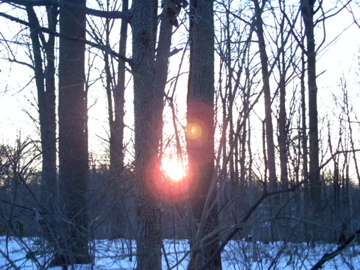
The hooting began around 5:30 this evening and continued at regular intervals for about 20 minutes. The weather was for the first time in recent memory, much warmer (in the 40s) and sunny. The sunset made a nice glow on the forest.
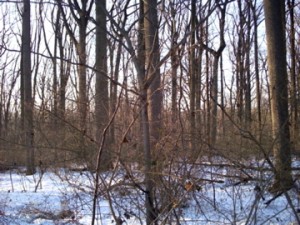
Today the volunteer staff of the Sanguine Root focused on removing vines growing on small trees in an especially hard-hit area.  We encountered a variety of situations and species.  The biggest success story is a mature Dogwood tree (Cornus Florida) that had grape vines  all over it last Spring, hanging so heavily, the tree was in danger of collapse.  In June of 2010, the vines were clipped. Today, those vines were removed from the tree, leaving it with a great form and intact integrity.  Hopefully it will flower this upcoming spring.
The Grape vines had claimed another Dogwood however. This one had all of its main branches broken.  The vines were removed and  the broken branches pruned off.  There is hope because new shoots were coming up from the stump-like top of the tree.
As much as we love the native grape vines, they are a woodland edge species, that grow in areas with a decent amount of sun, like river banks, and the edges of forests. In the blighted areas of Morris Park, the woodland edge species have an advantage when there are so many trees missing from the equation. With this advantage, they can become aggressive and destructive, perpetuating a situation of canopy holes, which benefits the vines further.
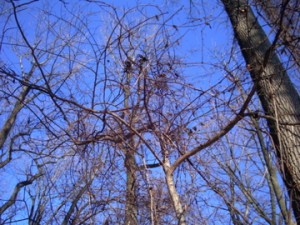
With the issue of grape vines, we must ask ourselves, what do we want? Â If we want a forest, then the vines need to be controlled and monitored, so that trees can grow from saplings to maturity.
Being that our section of Morris Park is a Fairmount Park woodland area, it is our mandate to maintain this status.
Whether or not the grape vines that are growing here are even native has not been determined to our knowledge.
The Sassafrass tree to the left was in danger of having all of its main branches broken. Â However, this afternoon, the vines have been removed, and the tree should be good to go. This specific specimen had a great well rounded sassafrass form, and it contributes to the health and well-being of this forest under stress.
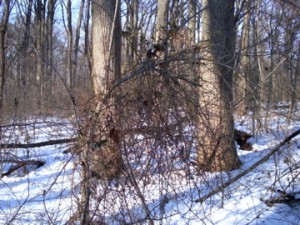
This one we have not yet been able to identify. Â It may be a crabapple. The Rosa multiflora and the Lonicera japonica (Japanese Honeysuckle) were having the run of the place until they met Isabelle Dijols (Homo sapiens sapiens). Â After the vines have been removed, this tree now has a chance of survival. Â We will revisit this specimen, identify it and rephotograph it in the spring. Look forward to updates on this specific tree. ( note the iconic pair of Tulip Poplars in the backround (Liriodendron tulipifera).
In just a few hours time, many trees and shrubs were de-vined. Â A fine specimen of Black Cherry (Prunus serotina) was de-vined and there were numerous Spicebush (Lindera benzoin) that were over-run with Lonicera japonica . Also notably, was Pignut Hickory (Carya glabra). Â The hickories fare the best when covered with vines, although they can still be broken and severely compromised . Even the tree that is used for hammer, axe and mattock handles can be brought down by invasive vines.
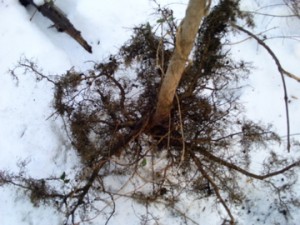
The Burning bush (Euonymus alatus) was pervasive in this area, and we pulled them up. Â The shallow root system and the loose soil makes this possible. With this plant, we always make sure we get every part of it out of the soil, otherwise it will regrow. Removing it from the soil requires lots of gentle tugs and back and forth movements. Eventually we can actually pull up on the stem and get the whole plant out, leaving no roots behind. The best time to do this is when the soil is wet and loose, like it was today.
Once removed, we try to put the soil back the way it was and put the leaf layer back on top. Soil is to be disturbed as little as possible. The best work is the work unnoticed, as if there was never a problem in the first place. Disturbed soil can lead to all kinds of problems. Â Invasive plants can get a better foothold in disturbed soil, from seed germination to encroachment from roots.
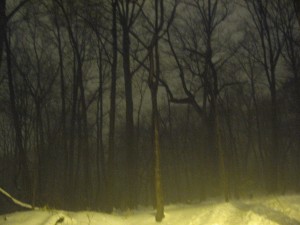
It was a quiet and peaceful day in Morris Park. Â One of our pruners lost a spring and 15 minutes was spent looking for it with no success. One specimen of Japanese Barberry was found with some alarm. Many small trees and shrubs have been readied for the spring.
The last photo here was taken last night as a gentle fog rolled into the area. Â Fog is a welcome sight in the beginning of February. A subtle reminder of spring that is only less than 50 days away.


